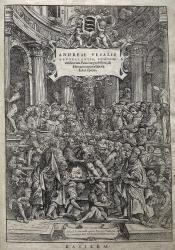Vesalius publishes his anatomical treatises
Because da Vinci failed to publish his anatomical notes to the public himself, the next time the information was seen was in influencing Andreas Vesalius's De humani corporis fabrica libri septem, a collection of books that went over human anatomy in a similar level of detail to da Vinci's notes. Like da Vinci, Vesalius personally dissected human corpses in an effort to provide the most immediate and accurate description of the human body possible; also like da Vinci, he took advantage of recent advance in printmaking technology to widely disseminate drawings more accurate than any available at the time - technology which relied heavily, in turn on some of Leonardo's advances during the Rennaissance, including his style of careful realistic sketching. Prior to Vesalius, dissections were generally done by a second person under the direction of the doctor giving the lecture; thus, this publication was unmatched in the fidelity and detail of its descriptions.
It was Vesalius's publication that finally disproved Galen's theories, making widely-known some discoveries that da Vinci had found nearly a generation prior (such as the heart's place at the center of a complete circulatory system, the lack of any anatomical evidence for Hippocratic humoral theory, and discrepancies caused by Galen's use of animal specimens).
Sources:
"De humani corporis fabrica." https://en.wikipedia.org/wiki/De_humani_corporis_fabrica. Accessed 8 Mar. 2018.
Image source: https://en.wikipedia.org/wiki/File:Vesalius_Fabrica_fronticepiece.jpg

